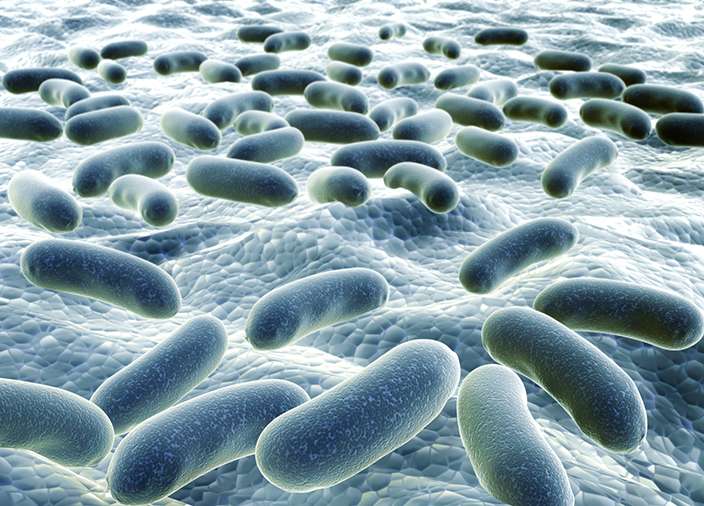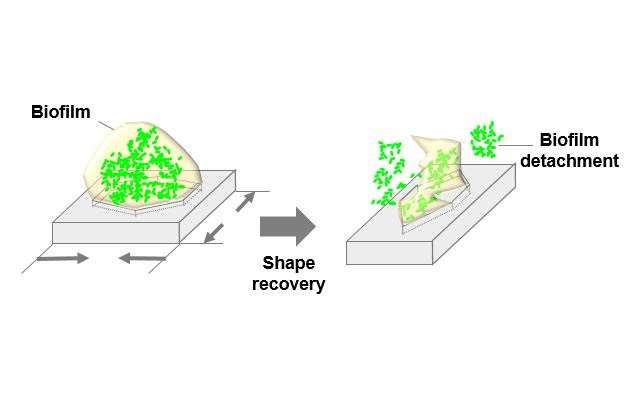Researchers discover way to make surfaces less vulnerable to disease-causing bacteria

Microbes, specifically disease-causing bacteria, can cause all sorts of havoc when they take hold on surfaces.
If they aren't removed quickly using the right amount of cleaning agent, they can rapidly propagate and become resistant to some cleaners and even antibiotics. These "superbugs," which include methicillin-resistant Staphylococcus aureus (MRSA), are difficult to treat and can gain a foothold in such places as medical settings.
Professor Dacheng Ren, in the Department of Biomedical and Chemical Engineering (BMCE) in the College of Engineering and Computer Science and the Syracuse Biomaterials Institute (SBI), and his team of researchers are seeking ways to stop the spread of microbes, and they may have found a solution.
In a recent study, the researchers collaborated with the lab of Associate Professor James Henderson (also in BMCE and SBI) and discovered that the use of shape-shifting polymers with topographic patterns as surfaces effectively reduces the adhesion of microbes and can remove up to 99.9 percent of attached cells.
The results appeared in the article "On-Demand Removal of Bacterial Biofilms via Shape Memory Activation" in the journal of ACS Applied Materials and Interfaces. The postdoctoral student researchers who also worked on the project are Huan Gu, Sang Won Lee and Shelby Lois Buffington.
"Microbes like to attach to surfaces," Ren says. "Basically anywhere you have water, you could have a so-called biofilm—a cluster of microbial cells that stick together. They also produce a polymeric matrix that gives them protection."
This makes them problematic for multiple reasons.
"Number one is it's very hard to kill them. Once they clump together and form a biofilm, you need up to about 1,000 times more antimicrobial agents—such as antibiotics and other cleaning agents—to kill them," Ren says.
The second problem relates to their closeness. "They can share genes and the DNA around them. Once a cell becomes resistant to something, another can become resistant," Ren says. "They can teach other because they are so close to each other."
Biofilm is really the city of the microbes, Ren says. "The biofilm protects them and allows them to survive under stress and over time to mutate and become permanently resistant to the control agents we use, especially antibiotics. That's why we need to worry about them," he says.

Researchers in the field are looking at how to engineer a material or a surface to be less vulnerable to microbial adhesion and biofilm formation—making it less welcome to them. Earlier published work by Ren's group showed that engineering surface topography could be impactful.
"Just as you like to walk on certain surfaces but you don't like to walk on other surfaces, microbes are the same way," Ren says. "You understand what they prefer and engineer the surface so they don't come to it. That's one of the strategies."
In that particular paper, Ren and his team used hexagon patterns on the surface to reduce biofilm by about 50 percent. However, because it does not offer total prevention, over time the microbes can slowly take over. That is the challenge in controlling them—on a static surface it will only work for a certain amount of time.
"The motivation for us was to create a surface that can potentially change after a biofilm has formed," Ren says. "This approach we did something different; we changed the surface when needed so you can slide them off the surface, basically."
The surface has a certain topography and then suddenly another—essentially breaking the microbes' grip on the surface in the process. Ren and his group used a material that had been created before, but they discovered a new way of using the dynamic topography for biofouling control. "We're ultimately changing topography, using an existing material that is known to be biocompatible, meaning it doesn't kill cells," Ren says.
This class of polymers has a permanent shape and a temporary shape. "You begin this application with a temporary shape, so you have some success for reducing adhesion. But bacterial cells can still attach to it over time and grow biofilms and, at that point, the initial topography has lost its function," Ren says. "However, then we can trigger the change of surface topography within minutes. In front of your eyes you can see the change if you have a microscope. And then you can see the cells come off."
Based on previous research that was supported by the National Science Foundation and the National Institutes of Health, the recent work reduced Pseudomonas aeruginosa biofilms by 99.9 percent compared to the static flat control. It was also successful in removing biofilms of Staphylococcus aureus and an Escherichia coli strain that can cause urinary tract infections.
This area of shape memory polymers has been studied by material scientists and now the technology can be used in the field of bioengineering for control of contamination.
"It's a good interdisciplinary application of polymer science and material science and microbiology," Ren says, noting the work that Henderson's lab played in the current research. "This is collaborative work. The Henderson group has more experience in shape memory polymer and he helped us characterize some of the features of the polymers."
Some of the shape memory polymers can also be engineered to have more than two stages. "Eventually we want to do something that can do cycles," Ren says. "The next step would be to apply this to more novel materials with more complicated or more sophisticated ways of shape change and also to find more gentle conditions for biocompatible materials and real effective applications. We are also studying the effects of such detachment on the physiology of biofilm cells."
More information: Huan Gu et al. On-Demand Removal of Bacterial Biofilms via Shape Memory Activation, ACS Applied Materials & Interfaces (2016). DOI: 10.1021/acsami.6b06900
Journal information: ACS Applied Materials and Interfaces
Provided by Syracuse University
















